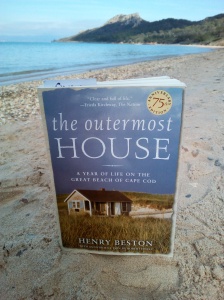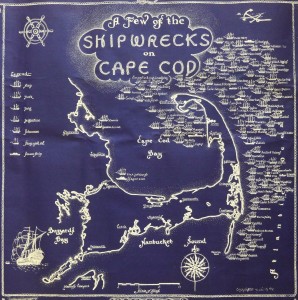A Year of Life on the Great Beach of Cape Cod

Reading Beston on Plage de Notre Dame, Porquerolles Island, France
Originally published in 1928, and still in print today, this is perhaps one of the early examples of literary nature writing, an account of a year spent living among the sand dunes of the great peninsula of Cape Cod, living closer to the ‘rough sea nature’ in all her aspects than most humans do and observing all that passes through and by, using all the senses.
Having planned to stay two weeks in his newly built house on the sand dunes, Henry Beston’s fascination with the changes of the dunes, the tides, the sky, the migration of birds and butterflies keep him captivated; thus he keeps extending his stay, observing the minutiae of life and nature, writing it into this book.
I first came across the title while reading one of my favourite nature writing books by Rachel Carson, Under the Sea-Wind, in which she mentions this volume as one of her inspirations.
 And though I enjoyed Henry Beston’s book considerably, Carson’s book for me left a greater impression, for who could not forget being made to see life through the eyes of the very creatures Henry Beston observes. Carson chose to narrate the three parts of her book from the point of view of a sanderling (bird), a mackerel, and a migrating eel. If you haven’t read it and loved this book, I am sure you will enjoy and appreciate Rachel Carson’s personal favourite of all the books she wrote, it is the perfect companion to The Outermost House.
And though I enjoyed Henry Beston’s book considerably, Carson’s book for me left a greater impression, for who could not forget being made to see life through the eyes of the very creatures Henry Beston observes. Carson chose to narrate the three parts of her book from the point of view of a sanderling (bird), a mackerel, and a migrating eel. If you haven’t read it and loved this book, I am sure you will enjoy and appreciate Rachel Carson’s personal favourite of all the books she wrote, it is the perfect companion to The Outermost House.
I got the impression Henry Beston may have been something of an insomniac, or perhaps it was because during winter he abandoned the cold bedroom and slept in his front room, where there was the warmth and then cooling of the fire and the changing light of the seven windows he’d included in his simple design. Often throughout the book, he wakes in the night and so making the most of it, seeing these awakenings as an unwitting opportunity, he dresses and goes out to see what’s up. And though we might think that one night must surely be just like another, he always finds something new to observe, reflect on and write about.
He was often visited by the “surfmen” who patrolled the coastline, making sure he’d survived the latest storm, men he said knew the conditions of that coast like no other, not as sailors, but like those who are land based who watch and develop their knowledge and instinct as he learned to, observing how quickly the elements could change and become violent, showing little compassion for floating man-made vessels that attempted to navigate its peripheries.
 It was the late 1920’s and no doubt a year like any other, with its share of wrecks, disasters. The pragmatic attitudes of the locals, as likely to come to the rescue and do anything to help, as they are to salvage what is left, not always understood by the families of victims of the many shipwrecks.
It was the late 1920’s and no doubt a year like any other, with its share of wrecks, disasters. The pragmatic attitudes of the locals, as likely to come to the rescue and do anything to help, as they are to salvage what is left, not always understood by the families of victims of the many shipwrecks.
“a wreck was treasure trove, a free gift of the sea; even to-day, the usable parts of a wreck are liable to melt away in a curious manner.”
To get a feel for the prose, I’m sharing a few more of the passages I highlighted as I read, they best portray a sense of his experience and lyrical turn of phrase.
He develops a compassion and understanding for birds and animals and insects that he finds at odds with what an education (or perhaps religion) has taught him, he questions the self-perceived superiority of man and wonders that we ought not perhaps rethink this arrogance.
“We need another and a wiser and perhaps a more mystical concept of animals. Remote from universal nature, and living by complicated artifice, man in civilisation surveys the creature through the glass of his knowledge and sees thereby a feather magnified and the whole image in distortion. We patronise them for their incompleteness, for their tragic fate of having taken a form so far below ourselves. And therein we err, and greatly err. For the animal shall not be measured by man. In a world older and more complete than ours they move finished and complete, gifted with extensions of the senses we have lost or never attained, living by voices we shall never hear. They are not brethren, they are not underlings; they are other nations, caught with ourselves in the net of life and time, fellow prisoners of the splendour and travail of earth.”
He attempts to put into words, his great awe and the magnificence of the ocean, implying that of nature’s three great elemental sounds in nature (the rain, the wind and the sound of outer ocean on a beach) the ocean is the most awesome, beautiful and varied.
“For it is a mistake to talk of the monotone of ocean or of the monotonous nature of its sound. The sea has many voices. Listen to the surf, really lend it your ears, and you will hear in it a world of sounds: hollow boomings and heavy roarings, great watery tumblings and tramplings, long hissing seethes, sharp, rifle-shot reports, splashes, whispers, the grinding undertone of stones, and sometimes vocal sounds that might be the half-heard talk of people in the sea. And not only is the great sound varied in the manner of its making, it is also constantly changing its tempo, its pitch, its accent, and its rhythm, being now loud and thundering, now almost placid, now furious, now grave and solemn-slow, now a simple measure, now a rhythm monstrous with a sense of purpose and elemental will.”
He is prone to talk of the sounds of natures as if they were a symphony of his making.
“As I muse here, it occurs to me that we are not sufficiently grateful for the great symphony of natural sound which insects add to the natural scene; indeed, we take it so much as a matter of course that it does not stir our fully conscious attention. But all those little fiddles in the grass, all those cricket pipes, those delicate flutes, are they not lovely beyond words when heard in midsummer on a moonlight night.”

Cape Cod Birdlife by Janet DiMatta
A delightful read that I enjoyed even though I have never visited the area, it does make you wish to see it for yourself, a unique ecosystem and landing point between here and there for so many species, one that Henry Beston has succeeded in depicting so well, it has ensured his book has become a classic, continued to be read, reread and appreciated by multiple generations of readers.
To see some pictures of the house, you can visit the website Outermost House.

A plaisir to read this beautifully written review. Would love to read this and the Rachel Carson.
LikeLiked by 1 person
Yes, this is what I’ve been doing on this lovely, overcast afternoon 🙂
LikeLike
Lovely post, Claire. It looks as if Beston lived so close to the shoreline he was practically in the ocean at times
LikeLiked by 1 person
That’s right and I did read that the house, which he named Fo’castle (raised bilingually, his mother was French), had to be moved back twice before it was eventually destroyed by one of the more violent tempests known to hit the area, described here in the introduction:
It seems a fitting end, having read all that he managed to endure, nature does often reclaim what is rightfully hers eventually for the good of all interdependent species and the ecosystem.
LikeLiked by 1 person
That gives ‘living on the edge’ a whole new resonance! There are several cliff areas around the UK coastline which are gradually crumbling into the sea.
LikeLiked by 1 person
Yes, and similarly in Christchurch, NZ there were a number of hilltop dwellings that had to be abandoned after the earthquake, no place is without risk.
LikeLike
Sounds like a couple of fascinating additions to the TBR pile
LikeLiked by 1 person
If you enjoy the likes of Annie Dillard and Kathleen Jamie, you may enjoy these classics of nature writing, I find them quite compelling reading.
LikeLike
I’ve never come across Henry Beston. Thank you. I’ll look out for him.
LikeLike
Ooh, I hadn’t heard of this one. But I haven’t read Under the Sea Wind either. I didn’t realize it was written from the perspective of the animals. Interesting.
LikeLike
Oh Claire, how lovely to read your review of one of my favorite books and one, which as you said in your comment to me, I quote from often !!!!!
One of the joys of reading is sharing the books one loves with others, and I love talking about books too, so this masterly and beautifully written review was a glorious substitute for both… So you are an Annie Dillard fan too? Pilgrim at Tinkers Creek et al ????
I should have known it !!!
Having trouble with my e-mails – someone ( is it a troll? ) has clicked like on nearly every blog I’ve written, – without having read, I can tell from the timing, and it’s completely wrecked my system, so I can’t find your comment on this book in order to answer it…
LikeLike
This is one of my all-time favorites – I’m glad you enjoyed it! Reading your review makes me want to read it all over again. I recently visited the site and have been meaning to write a post about it. It’s still peaceful there even though so many other things have changed.
LikeLiked by 1 person
I’ve had a love affair going with Cape Cod for 20 years. I especially like Cape Cod’s more remote areas, such as its Outer Beach, which is where Beston lived in his “outermost house.” I’ve wanted to read Beston’s book for years, and finally did so this week. It’s terrific, as you say. Another great read is Thoreau’s Cape Cod book.
LikeLike
It’s a wonderful book and a wonderful appreciation for the wild seashore environment, I don’t know Cape Cod, but I grew up near the wild, black, volcanic sands and dunes of Port Waikato on the West Coast of New Zealand, a place where the river meets the sea and where I believed the local Maori legends and sayings about the dangers of the sea, such as “never turn your back on the sea, or the taniwha (a kind of sea monster) will get you”, it’s probably why I like books that immerse us back into those windswept, wild habitats that are constantly shifting, changing and hold little sympathy for man. Thank you for sharing your thoughts and for the recommendation.
LikeLiked by 1 person